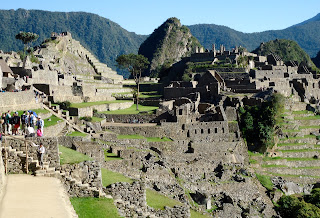In Ecuador it's "almuerzo", in Peru it's "menú"- in either place it's a great deal! For about $2 USD in Ecuador, less than $3 in Peru, you get a large bowl of soup, a drink (usually fruit juice), choice of a main plate, and sometimes even a dessert!
A couple of my favorite dishes are tallarines verdes - spaghetti with a spinach and basil pesto sauce, and lomo saltado - like chinese beef stir fry, served with french fries, over rice.
Another of my favorite foods is causa rellena - mashed potatoes with a layer of avocado and a layer of chicken (or tuna) salad - sound weird but tastes great!
 |
| Typical Restaurant with Menú sign |
 |
| soup |
 |
| Tallarin Verde / Chuleta |
 |
| lomo saltado |
 |
| causa rellena |

























